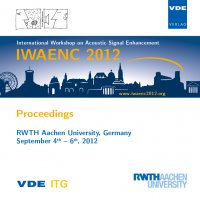Robustness Analysis of Speech Enhancement Using a Bone Conduction Microphone – Preliminary Results
Conference: IWAENC 2012 - International Workshop on Acoustic Signal Enhancement
09/04/2012 - 09/06/2012 at Aachen, Germany
Proceedings: IWAENC 2012
Pages: 4Language: englishTyp: PDF
Personal VDE Members are entitled to a 10% discount on this title
Authors:
Srinivasan, Sriram; Kechichian, Patrick (Philips Research, Eindhoven, The Netherlands)
Abstract:
Previously, the use of a bone-conducting sensor worn on the neck was shown to improve the performance of a codebook-based speech enhancement system for non-stationary noise suppression, while reducing computational complexity. This system relies on a mapping between bone-conducted and air-conducted signals that is learned during an offline training phase for a certain location of the sensors. Signal properties such as speech intensity, quality, and intelligibility are more location-dependent for a bone-conducting sensor. This paper studies aspects of robustness related to location-errors between the original training location and those used in practice. The two main regions considered for sensor placement are the neck and temple areas to understand the benefits and tradeoff between higher signal-to-noise ratio (neck) and higher speech intelligibility (temple) for such a system. Index Terms — Speech enhancement, bone conduction, codebook, linear prediction, intensity, speech intelligibility


